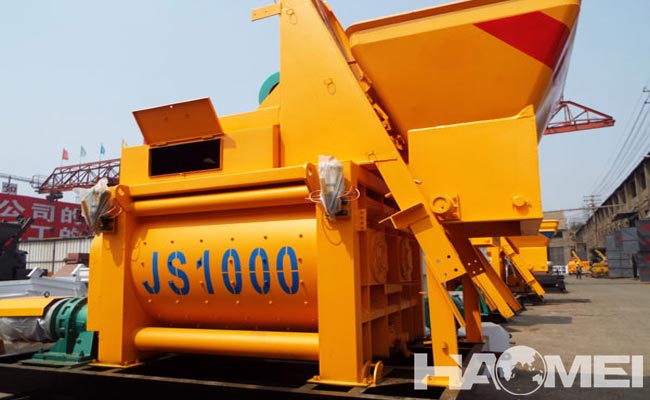Categories
- Case & News (50)
- Blog (564)
Automatic concrete mixers for construction projects are concrete mixing equipment integrated with automated control technology. They are primarily used in construction projects to automatically complete the entire process of batching, mixing, and unloading raw materials, including sand, gravel, cement, and water, according to preset mix ratios. This significantly improves the efficiency, precision, and stability of concrete production.

1. Core Features of Automatic Concrete Mixer
– Fully automated processes:
From raw material metering, loading, mixing, to unloading, all operations are automated through programmable settings, eliminating the need for manual intervention.
– High-precision mix ratios:
Utilizing sensors and metering systems, these concrete mixers ensure a ratio error of ≤±1% for cement, sand, gravel, water, and admixtures (up to ±0.5% on some high-end equipment), ensuring stable concrete strength and other properties.
– Efficient and continuous operation:
Single-batch mixing times can be controlled within 60-120 seconds (depending on concrete type), with hourly production rates ranging from 10m³ to over 100m³, adapting to project sizes of varying sizes.
– Intelligent control:
These concrete mixers support recipe storage (preset recipes for multiple concrete grades are possible), fault self-diagnosis (e.g., silo shortage and motor overload alarms), and some equipment can be connected to project management systems for remote monitoring.
2. Main Components of Automatic Concrete Mixer
– Mixing System:
The core is the mixing drum (mostly a twin-shaft or single-shaft structure). Built-in blades rotate at high speed to evenly mix the materials. The drum wall is typically coated with a wear-resistant coating to extend its service life.
– Automatic Batching System:
Silos: Separate silos store dry materials such as cement, sand, gravel, and fly ash, and liquids such as water and admixtures.
Metering Device: A belt scale/screw scale is used for dry materials, while a flow meter/load cell is used for liquids, providing real-time feedback on material weight.
Loading Mechanism: Dry materials are fed into the mixing drum via a belt conveyor or elevator, while liquids are delivered via a water pump/metering pump.
– Control System:
Based on a PLC (Programmable Logic Controller), it features a touchscreen interface for parameter setting (e.g., mix ratio, mixing time), status monitoring (e.g., progress of each stage), fault alarms, and supports manual/automatic mode switching.
– Discharging System:
A discharge port is located at the bottom of the mixing drum, controlled by a hydraulic/pneumatic gate. It can be connected to a concrete truck or used for direct pouring.
– Power and auxiliary systems:
Includes a motor (driving mixing and loading), a hydraulic station (controlling gates and lifting), and a dust removal device (reducing cement dust).
3. Working Principle of Automatic Concrete Mixer
The operator selects a preset recipe (e.g., C30 concrete) via the touchscreen, and the system automatically calculates the required amounts of each material.
The batching system delivers the set amounts of dry materials (sand, cement) and liquids (water, admixtures) to the mixing drum, with metering devices calibrated in real time.
Once the materials enter the mixing drum, the agitator shaft drives the blades to rotate at high speed (typically 15-30 rpm), mixing the materials uniformly through shearing and tumbling for the set mixing time (e.g., 90 seconds).
The system automatically opens the discharge port and discharges the concrete to a designated device (e.g., a tank truck), completing one cycle. The system also automatically detects the remaining material in the silo and issues an alarm prompting refills if the material is low.
4. Applicable Scenarios of Automatic Concrete Mixer
– Small and medium-sized construction projects: such as housing construction, municipal roads, and small bridges, require on-site concrete preparation;
– Precast component plants: Production of precast panels and pipe piles requires a stable concrete mix ratio;
– Emergency projects: Emergency reinforcement projects require rapid and continuous concrete supply;
– Applications requiring high concrete quality: such as high-speed rail base slabs and water conservancy projects require strict control of mix tolerances.
5. Key Points for Purchasing Automatic Concrete Mixer
– Mixing Capacity: Select according to the project’s daily production needs. For example, if the daily demand is 50 m³, choose a 2 m³/batch (approximately 20-30 m³ per hour). For large projects, choose 4 m³/batch or higher.
– Metering Accuracy: Prefer equipment with a metering error of ≤ ±1% to avoid inaccurate mix ratios that affect concrete strength.
– Automation Level: For remote monitoring, choose equipment with IoT functionality. For frequent recipe changes, choose models that support multiple recipe storage (≥10).
– Stability: For core components (such as the mixing motor, PLC controller, and sensors), choose reputable brands (such as Siemens and Schneider) to minimize downtime.
– Mobility: For dispersed construction sites, choose a mobile concrete mixer (with tires or tracks). For fixed-site production, choose a stationary concrete mixer (which can be integrated with the concrete mixing plant).
6. Maintenance Tips of Automatic Concrete Mixer
Clean any remaining concrete from the mixing drum daily to prevent blade wear after solidification.
Regularly calibrate metering devices (1-2 times per week) to ensure mix accuracy.
Lubricate the agitator shaft bearings and hydraulic system, and check the belt/chain tension.
Clean sensor surfaces (such as level sensors and load cells) to prevent dust from affecting detection accuracy.
In summary, automatic concrete mixers, through automation technology, address the low efficiency and unstable mix ratios of traditional manual mixing methods. They are key equipment for improving construction quality and efficiency in modern construction projects.